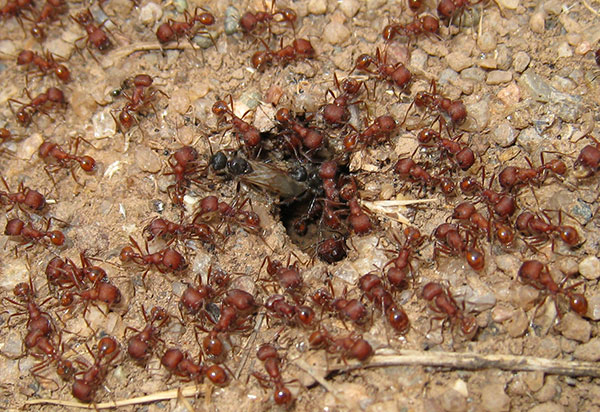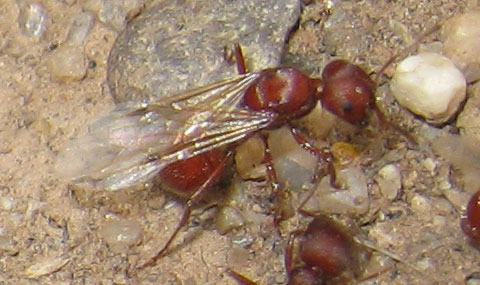By Jennifer Macke
Right now is a good time to observe winged ants. In summer, mostly from late June through early August, ant colonies produce winged ants, called alates. Both male and female alates are produced, and their purpose is to make new colonies. They emerge from the ant colony, fly around, and mate in mid-air. When the mated female returns to the ground, she sheds her wings and walks around looking for a place to make a nest.

Our local harvester ants (Pogonomyrmex barbatus) are just now producing winged ants. These photos were taken on Barranca Mesa on June 24th. For harvester ants, it’s very easy to tell the male and female alates apart – the males are black, females red. For most other species of ants, the sexes can only be distinguished by differences in body size or shape.

The best way to start an ant colony in captivity is to find a female that has shed her wings (a de-alate ant). It might seem like an impossible task to find such an ant, but it’s easier than it sounds. New queens may spend a long time looking for a place to make a nest, so they sometimes walk around in strange places, like sidewalks and patios. During prime ant season, they are everywhere, so some of them end up in places where they are easy to see.
New queen ants can be distinguished by the following characteristics:
- Large abdomen.
- Large thorax (because of the wing muscles).
- Small head relative to the rest of the body. With the large abdomen and thorax, the head seems small by comparison. In other words, the proportions of the 3 body segments look unusual, compared to worker ants.
- Large size overall. While a queen are generally larger than workers of the same species, ant species come in all sizes, so this isn’t always a useful indicator. But for some of the larger ant species, such as carpenter ants, the queens stand out as surprisingly large.
- Slow speed. Queen ants usually walk more slowly than workers. They are easy to catch by corralling them into a ziploc bag.
- Odd behavior. While worker ants appear to be “on a mission” and usually move in one general direction, prospective queens may look aimless or walk back and forth in one area.
- Wings. In some cases, a mated queen can be found while she still has her wings. However, a winged ant that has just emerged from the nest will generally not be fertile yet (she’s still just an alate, not a queen).
Not every queen will have all of these characteristics. Once you catch an ant and look at it up close, there is one definitive test of whether it is a nascent queen: wing scars. These can be seen clearly with a good hand lens. You can see the wing scars in some of the photos below.
Once you know what to look for, it’s fun to try to find alates and new queen ants. Happy hunting!





